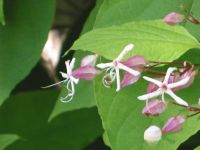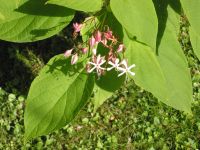Harlequin Glory Bower, Chance tree - Clerodendrum trichotomum
English name:
Harlequin Glory Bower, Chance tree
Scientific name:
Clerodendrum trichotomum
Family:
Verbenaceae (verbena or vervain)
Height:
2.5 M in Hørsholm
Flowering:
August & September
Range:
China, Korea, Japan & south to Philippines
 |
|
 |
 |
The Clerodendrum trichotomum plant in the pictures is from seed collected by the Nordic Arboretum Committee expedition to Korea in 1976. The seed was collected on Mt. Palgong San on the border of Gyeongsangbuk Province. They can be found in square 917 positions 2501 growing on the south side of Clausens house which is the first house one meets when entering the Arboretum through the main gate. A map with squares and positions can be found on our homepage under: Plant search.
Plant description:
Here is a colourful plant in the same family as teak trees (Verbenaceae). One of my early experiences at the Arboretum was involved in moving our Clerodendrum trichotomum plants from one spot to another. It had become too large blocked light from entering the office window of one of our researchers. As described in several books it was easy to transplant and it can be weedy. Some roots remained in the original spot and they have since sported new shoots which are now nearly as large as the original plants and they are now it is crowding out other plants that are meant to grown there.
The genus Clerodendron comprises about 400 species, most of which are warm temperate or tropical. They come as trees, shrubs and scramblers. We have only one species growing in our Arboretum and it is near its climatic limits in Hørsholm. There are only two examples of this species registered in our collection, both of the same Korean provenance.
The name Clerodendrum is derives from the Greek word for chance (klero) and tree (dendrum). This refers back to the trees original species name fortunata. The species name, trichotomum, refers to the three-lobed juvenile-leaves this species sometimes produces. Clerodendrum trichotomum was introduced into European cultivation around 1800. It was described as early as 1916 in an early Danish book on trees and bushes, and it was sold by the Danish nurseryman Aksel Olsen as early as 1928. It was tried in Hørsholm already in 1937. Our oldest living plants however date from 1977.
Clerodendrum trichotomum (Nu-ri-jang-na-mu in Korean) has eatable leaves (boiled to remove the odour). The wood has been used to make clogs and the berries to make dyes. Grubs in the trunk are reported to be toasted and given to children in Japanese villages to eat to calm them down. This species also known as a medicine-plant which has a proven ability to lower blood pressure. In the west, it is best know as an ornamental plant for the striking colours in late summer and autumn. The striking colours have resulted in one of its common English names: Harlequin Glory Bower. The odour of the rubbed leaves or cut shoots gives rise to another name peanut butter shrub and indeed as a regular eater of peanut butter I can say that it does remind me of the substance. However, in my opinion, peanut butter smells much better. These are large deciduous shrubs or small trees that reach 7 m in height in nature. The bark is grey and smooth with many lenticels. The leaves are situated opposite on the shoots. They are broadly ovate with a drawn out tip. Sometimes the margins are toothed (not on our plants). They have a broadly wedge-shaped base. The upper surface of the leaf is deep green with some bristly hairs and the lower surface is lighter green with hairs especially on the veins. The corolla is deeply 5 lobed with a rather long corolla tube, and long stamens and styles that project out of the flower some distance. The flowers are strongly fragrant and are reported to attract butterflies and moths. Flowering occurs over an extended period from and can occur simultaneously with ripening fruit. . The fruit is pea-sized drup ripening to glossy blue to black and subtended by a striking reddish calyx.
In Japan, this tree is common is sunny secondary forests of the cool-temperate and warm temperate zones preferring fertile soils and to be near streams.
Clerodendrum trichotomum forms shrub or small tree with striking flowers and fruit in the late summer and autumn. It is perhaps a plant for the butterfly garden. It is a plant for warmer situations. In The Forest Botanic Garden in Charlottenlund, the species produces its colourful fruit more regularly than in Hørsholm. Its branches only survive temperatures down to -15 to perhaps-20 °C depending on provenance, but our plants have the ability to re-sprout after cold winters.
References:
Bean, W.J. 1976 Trees and Shrubs Hardy in the British Isles Vol I. A-C Eight edition. John Murray publishers. 845 pp.
Kurata, Satoru. 1974. Illustrated Important Forest Trees of Japan Vol 2. (2nd edition) Chikyusha Co. Ltd. Tokyo. 265 pp. Lange, J. 1999. Kulturplanternes Indførselshistorie i Danmark indtil midten af 1900-talet. (Introduction History of Cultivated Plants in Denmark up to the middle of the 20th century). DSR Forlag, Frederiksberg C. 458 pp.
Mabberley, D.J. 1998. The Plant Book. The Bath Press, Bath, 858 pp.
Olsen, O. et al. 1997 Havens Planteleksikon. Træer og Buske. (Danish Plant Encyclopedia, Trees & Bushes). Det Danske Haveselskab Publisher, 674 pp.
Poor, J.M. & Brewster, N.P. 1996. Plants that merit attention. II. Shrubs. Timber Press Inc. Portland. Rushforth, K. 1999. Trees of Britain and Europe. Harper Collins Publisher. 1336 Pp.
